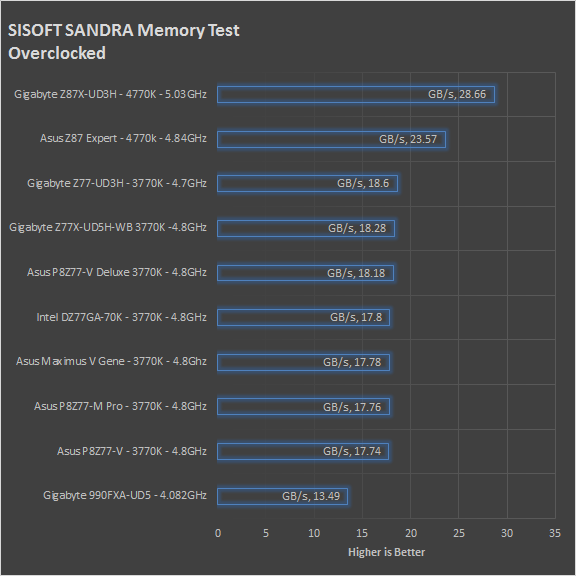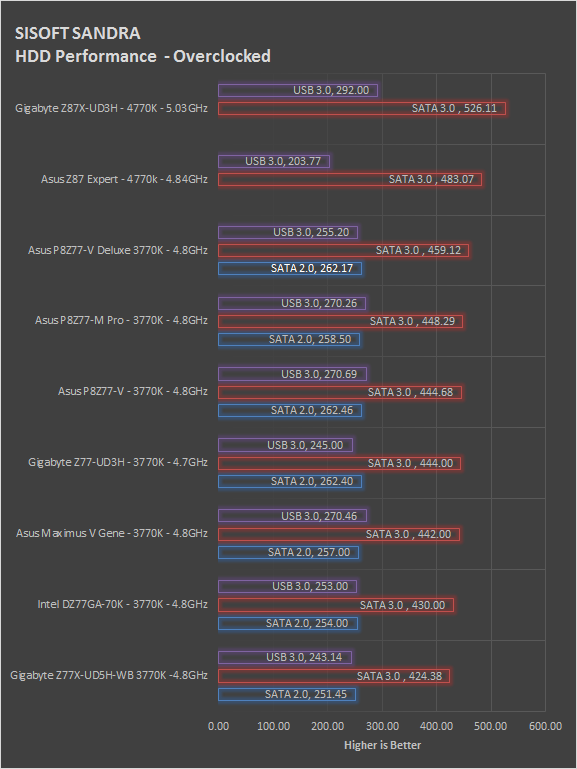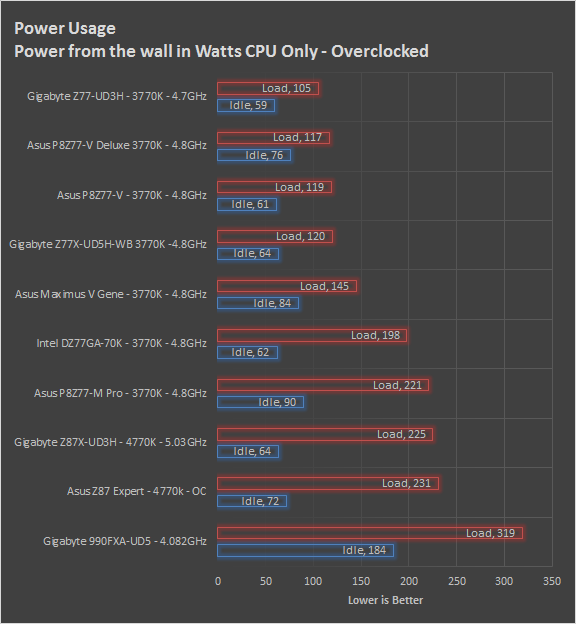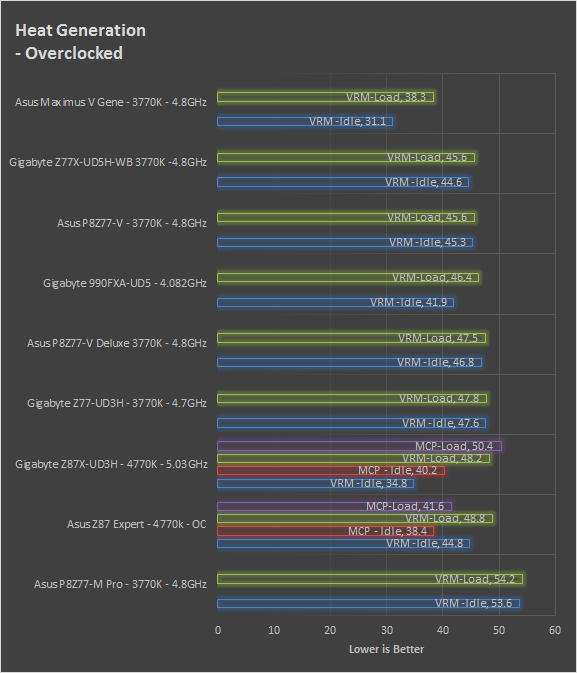Section 1 Subsystems
Memory -
Memory performance is very important on a motherboard, especially when you have a CPU with multiple cores and threads. If you have slow memory your cores and threads can become starved for data to execute. To test memory performance we run both Sisoft’s SANDRA and AIDA64. These two combine to not only give us accurate numbers but to validate each other. For testing at stock speeds the memory is hard set to 16000MHz while overclocking testing is done at the highest stable speed for the voltage of 1.55v this is due to the different memory dividers for each CPU. As such, the memory speeds will vary greatly. This means that the overclocked numbers are a little misleading and while they can show a trend are really only included to show if a board has a problem with memory performance at high clockspeeds. We tried something a little different this time. Instead of using our normal 1600MHz, we went ahead and wanted to see what we would get from pushing to 2133MHz. This is the second XMP profile on the Kingston 10Th anniversary kit that we use. The results are interesting to say the least.
At stock speeds the 2133 move gives us a fairly significant improvement over 1660MHz (duh right?). What is interesting is that this is at the same command rate and latency used for 1600MHz (CL9 and 1T). This not bad considering the fact that we had to tinker quite a bit with older Z77 boards to see the same performance levels at the higher memory speeds. The Gigabyte Z87X-UD3H actually does a very good job in keeping data flowing. During our overclocked run we saw a very nice jump in memory performance (much more than we expected). Gigabyte really tightened the performance curve for both stock and overclocked performance, at least where memory is concerned. This boost in memory speed should give us good performance in rendering, multi-tasking, and even in gaming (level loads).
During our overclocked run we saw a very nice jump in memory performance (much more than we expected). Gigabyte really tightened the performance curve for both stock and overclocked performance, at least where memory is concerned. This boost in memory speed should give us good performance in rendering, multi-tasking, and even in gaming (level loads).
Drive performance -
Drive performance is also one of the major subsystems that goes to make up the performance of a motherboard. For our testing we use Sandra and AIDA64 again. We only test with single drives for each type of controller present on the motherboard (unless it is a professional product where we will use RIAD 5 and/or 10). We have also begun using a Thermaltake USB 3.0 dock with another Kingston SCK30/240G 240GB SSD and a Kingston HyperX USB 3.0 Flash drive for our USB 3.0 performance. As a side note, we include the overclocked numbers here to make sure (again) that you are not going to see a major drop in performance due to minor instabilities at high clock speeds. Here things get a little interesting. Although the Z87X-UD3H is using the same Intel SATA 3.0 controller as Asus’ Z87 Expert Gigabyte’s board pulls ahead nicely at both stock speeds and when we push the CPU. It is an added bonus that should yield results in many of our other tests.
Here things get a little interesting. Although the Z87X-UD3H is using the same Intel SATA 3.0 controller as Asus’ Z87 Expert Gigabyte’s board pulls ahead nicely at both stock speeds and when we push the CPU. It is an added bonus that should yield results in many of our other tests.
Power -
Power efficiency is another of those misnomers that we get caught up in. We hear about idle states and power gates. But what does that mean to you and I? On the surface having power management that reduces idle power sounds great and can be a benefit to someone that leaves their system on for long periods of time (and inactive) but how a system handles power under load and the delta between the two states is often more important than the idle power usage numbers. We use only P3 Kill A Watt instruments for measuring power.

Ok, now we had previously hoped that we would see a significant drop in load power usage when running a Haswell CPU, but sadly that has not really materialized. While the power draw under stock conditions is not much higher than Ivy Bridge, we are still seeing a little increase. The Gigabyte Z87X-UD3H continues this trend and even pushes it a little higher under full load. When overclocked the power draw is much higher (as you would expect).
When overclocked the power draw is much higher (as you would expect).
Cooling (Board Level) -
Board level cooling is an important factor in product performance and longevity. Components like the chipset, VRM modules and even capacitors need to be kept relatively cool to prevent failure. As these parts are made of silicon, they have a thermal breakdown threshold; or melting point. At that temperature the actual transistors built into chip will begin to deform and break down. Granted, the threshold is often very high, but you still need to make sure that components stay away from this level of heat for longer product life.

Gigabyte’s VRM cooling on the Z87X-UD3H does a very nice job at keeping your CPU power regulators cool. When it comes to the “chipset” it is not as efficient.

During overclocking the cooling still manages to keep things under control, but not as well as the cooling on some of the other Z77 boards.
Audio -
Audio is highly subjective. What we find pleasing may sound “off” to you. That is always going to the problem with testing audio; results will vary too widely depending on the tastes of the listener. However, there are ways of measuring the audio output with an objective ear. There is also the issue of audio causing performance issues in gaming and video playback. The reason this is a potential source of concern is that all onboard audio CODECs (Compression/Decompression) are CPU controlled. This means that while the audio chip controls the audio levels and effects of the audio the actual work is done on the CPU. Usually this will not be a problem with today’s powerful CPUs. Even the lower and consumer level products can handle high-end audio these days. But again there is the chance that a bad design or software will hinder your system and performance. On the other side the limits of board space, cost, etc will also prevent the level of audio quality you can get from an add-in board. We test all audio parts with three media types, Movie (DVD), MP3 Music, and Gaming. These are pushed to our Tec On model 55 Tube Amp to see if we can detect any signal issues in the reproduction.
We will simply say that the audio on the Z87X-UD3H falls into the good enough category. It will do what you need it to, but if you are looking for good audio you will want to look into other options.
Networking -
This one is something that is a requirement anymore. If you have a computer, the chances are good (like 99%) that you are also connected to high-speed internet. With this you need a good and solid LAN chip to make sure that your data flows properly out and back. Gigabyte made the move to Intel network controllers on their newer boards. This is a good move for them as Intel has one of the better performance profiles when it comes to networking. Intel also has a much wider compatibility range than many of the other options. We had zero performance issues with the Intel controller on the Z87X-UD3H.



